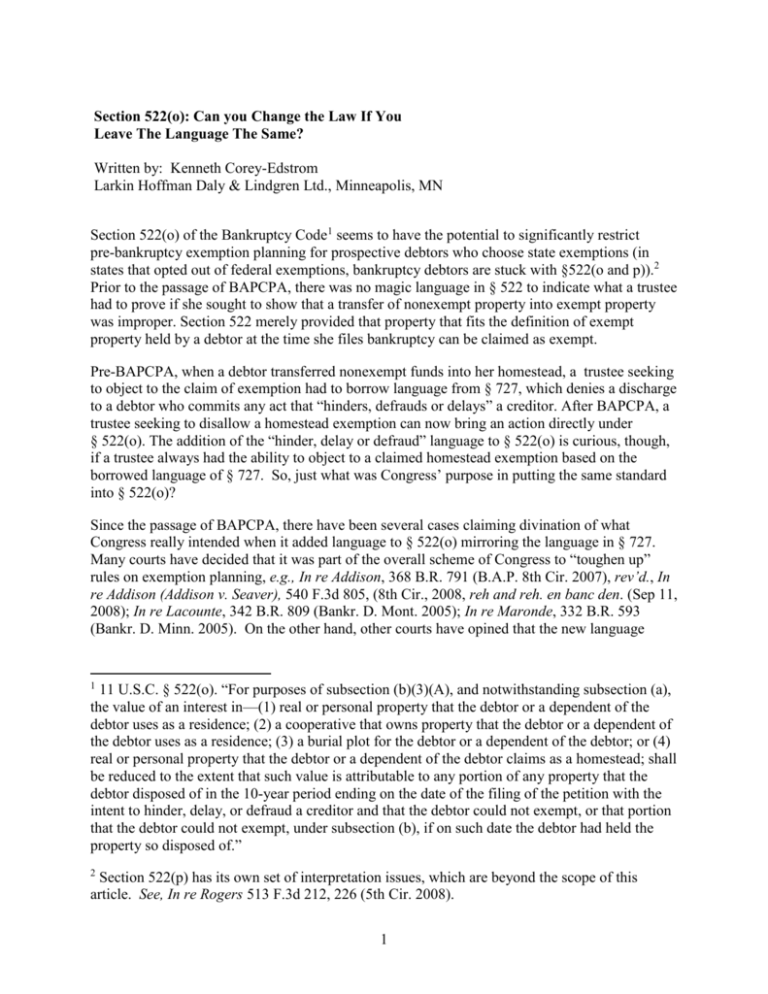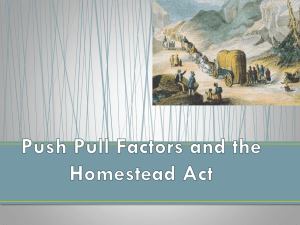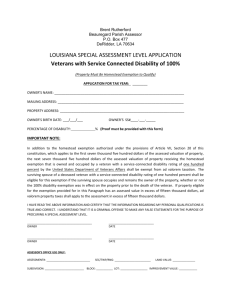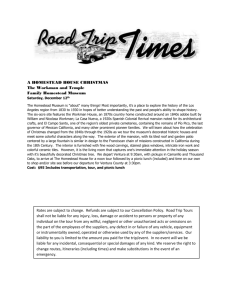ABI ABI Consumer Committee Article:
advertisement

Section 522(o): Can you Change the Law If You Leave The Language The Same? Written by: Kenneth Corey-Edstrom Larkin Hoffman Daly & Lindgren Ltd., Minneapolis, MN Section 522(o) of the Bankruptcy Code1 seems to have the potential to significantly restrict pre-bankruptcy exemption planning for prospective debtors who choose state exemptions (in states that opted out of federal exemptions, bankruptcy debtors are stuck with §522(o and p)).2 Prior to the passage of BAPCPA, there was no magic language in § 522 to indicate what a trustee had to prove if she sought to show that a transfer of nonexempt property into exempt property was improper. Section 522 merely provided that property that fits the definition of exempt property held by a debtor at the time she files bankruptcy can be claimed as exempt. Pre-BAPCPA, when a debtor transferred nonexempt funds into her homestead, a trustee seeking to object to the claim of exemption had to borrow language from § 727, which denies a discharge to a debtor who commits any act that “hinders, defrauds or delays” a creditor. After BAPCPA, a trustee seeking to disallow a homestead exemption can now bring an action directly under § 522(o). The addition of the “hinder, delay or defraud” language to § 522(o) is curious, though, if a trustee always had the ability to object to a claimed homestead exemption based on the borrowed language of § 727. So, just what was Congress’ purpose in putting the same standard into § 522(o)? Since the passage of BAPCPA, there have been several cases claiming divination of what Congress really intended when it added language to § 522(o) mirroring the language in § 727. Many courts have decided that it was part of the overall scheme of Congress to “toughen up” rules on exemption planning, e.g., In re Addison, 368 B.R. 791 (B.A.P. 8th Cir. 2007), rev’d., In re Addison (Addison v. Seaver), 540 F.3d 805, (8th Cir., 2008, reh and reh. en banc den. (Sep 11, 2008); In re Lacounte, 342 B.R. 809 (Bankr. D. Mont. 2005); In re Maronde, 332 B.R. 593 (Bankr. D. Minn. 2005). On the other hand, other courts have opined that the new language 11 U.S.C. § 522(o). “For purposes of subsection (b)(3)(A), and notwithstanding subsection (a), the value of an interest in—(1) real or personal property that the debtor or a dependent of the debtor uses as a residence; (2) a cooperative that owns property that the debtor or a dependent of the debtor uses as a residence; (3) a burial plot for the debtor or a dependent of the debtor; or (4) real or personal property that the debtor or a dependent of the debtor claims as a homestead; shall be reduced to the extent that such value is attributable to any portion of any property that the debtor disposed of in the 10-year period ending on the date of the filing of the petition with the intent to hinder, delay, or defraud a creditor and that the debtor could not exempt, or that portion that the debtor could not exempt, under subsection (b), if on such date the debtor had held the property so disposed of.” 1 2 Section 522(p) has its own set of interpretation issues, which are beyond the scope of this article. See, In re Rogers 513 F.3d 212, 226 (5th Cir. 2008). 1 changes nothing in interpreting homestead exemption planning. In re Agnew, 355 B.R. 276 (Bankr. D. Kansas 2006)3. A central principle of statutory construction is that language should be read plainly where it can be and that use of legislative history is a last resort. “In interpreting statutes, only after application of the principles of statutory construction, including the canons of construction and after a conclusion that the statute is ambiguous may the court turn to the legislative history.” Carrieri, v Jobs.com, Inc., 393 F.3d 508, 518-19 (5th Cir. 2004). Based on the “plain language” canon of statutory construction, using the same words should result in the same cases being decided in the same way. In the matter of: Peachtree Lane Assocs., Ltd., 150 F.3d 788, 796 (7th Cir. 1998). If, in fact, Congress intended to toughen up the standards for pre-bankruptcy homestead exemption planning, it certainly cannot be inferred by looking language of new § 522(o) which used the same language already in §§ 548 and 727. As the 5th Circuit has recently said concerning the meaning of 11 U.S.C. § 522(p), “[I]f Congress enacted into law something different from what it intended, then it should amend the statute to conform to its intent.” In re Rogers, 513 F.3d 212, 226 (5th Cir. 2008) (quoting the Supreme Court in Lamie v. U.S. Trustee, 540 U.S. 526, 542 (2004)). Courts who insist that § 522(o) has changed the rules concerning homestead exemption planning are going beyond the plain language of the statute and seem to be relying on legislative intent. These judges either do not cite their sources or, perhaps, are simply guessing at what Congress intended. Therefore, it is helpful to look at what legislative history exists regarding § 522(o) to determine if Congressional intent is being interpreted accurately. “A statute must be interpreted in a way that is not inconsistent with the purposes that the legislators had in mind at the time of the enactment of the statute.” Helvering v. New York Trust Co., 292 U.S. 455, 465 (1934); In re Beal, 347 B.R. 87, 92-93 (Bankr. E.D. Wis. 2006). On June 10, 1998, the Subcommittee on Commercial and Administrative Law of the House Judiciary Committee met concerning proposed amendments to H.R. 3150-Proceedings of the House Subcommittee on Commercial and Administrative Law, 144 Cong. Rec. H4404-H4407 (daily ed. June 10, 1998). The transcript of that meeting shows that § 522(o) was introduced as an amendment to the bill that would become BAPCPA. The amendment sought to strike a proposed homestead cap of $100,000.00 in exchange for the addition of a limit on the homestead exemption for debtors who transferred property into their homestead in an attempt to “hinder, delay or defraud” their creditors. The new language that would become part of Section 522(o) was passed by the House on a vote of 222 to 204 (Id. at H4438). A review of the debate on the amendment shows a lively exchange between those House members who wanted to protect the right of a state to determine their own bankruptcy exemptions and those who wanted to have a national federal maximum exemption on homestead rights. 3 In re Addison (Addison v. Seaver), 540 F.3d 805, (8th Cir., 2008, reh and reh. en banc den. (Sep 11, 2008), in reversing the 8th Circuit Bankruptcy Appellate Panel, agreed with In re Agnew: “We reject the Trustee's position that §522(o) provides a new standard for determining what type of evidence establishes a debtor's “intent to hinder, delay, or defraud” a creditor when the debtor converts nonexempt assets into his homestead. Rather, in our view, § 522(o) merely establishes a 10-year look-back period, from the date of the bankruptcy filing, from which such evidence may be considered.” Id., 540 F.3d at 813, n. 7. 2 I want to explain this amendment. It strikes the $100,000 homestead exemption cap that is in the bill and reverts back to current law in that respect. But it does a little more than that. In addition it denies the right of homestead exemption to somebody who within a year of filing bankruptcy takes assets, cash or whatever and places that into a home for the purposes of defrauding creditors to avoid paying the creditors. I think that is a very important provision that will get around the problems we are seeing people complain about on homestead exemption law abuse, but at the same time it will not deny the States the right to do what they have done since 1792 and that is to decide what property is exempt. I think that is a very important decision to be left to the States to decide. If we put this $100,000 cap in, we are going to dictate to the States; some States have no cap currently, some States have 100,000, some like Massachusetts have 100,000 until you are 62, and then they have 200,000. Id. at H 4404-H4405 (remarks of Rep. McCollum). We hear two arguments against [the national $100,000 maximum cap on homestead exemptions for individuals filing bankruptcy]. One is $100,000 is too low. This is $100,000 equity, and there are only 15 percent of the people in this country that have $100,000 equity in their home. The other is that it violates the Constitution or state rights. This is Federal Bankruptcy Courts, not state courts, Federal Bankruptcy Courts. Id. at H4405 (remarks of Rep. Barrett). Because the “states rights” arguments won out over the “national standard” arguments when the § 522(o) amendment passed in the House of Representatives, it is arguable that its passage evinced Congressional intent to not overrule existing case law concerning homestead exemption planning. That is, until § 522(o) was passed, when a debtor chose state exemptions, courts turned to state law in deciding whether a debtor “hindered, delayed or defrauded” creditors. In light of the House of Representative’s stated rationale for passing § 522(o) (to protect the right of states to interpret their own exemption laws with regard to homesteads), it seems incorrect to suppose that § 522(o) installed a uniform and harsher “federal standard” for homestead exemption planning.4 Therefore, whatever “hinder, delay or defraud” was interpreted to mean under prior precedents regarding exemption planning under § 727 should still be good law. To assume that the addition of § 522(o) should be used by the courts to strip away the precedent of using state law to determine the amount of permissible pre-bankruptcy planning is to interpret the law in a manner inconsistent with both the plain meaning of the statute and the purpose of the drafters in passing the statute. To paraphrase Forest Gump: statutory construction is as statutory construction does; courts are free to read the available legislative history of § 522(o) and come to a different conclusion. However, by looking at the plain language of the statute and the available legislative history regarding § 522(o), courts do not need to guess at what Congress meant and can rule on the basis of what the law says and what Congress intended when it wrote the law. 4 The homestead cap was put back in the bill in a limited fashion, and the concerns over individuals moving to unlimited homestead exemption states before filing bankruptcy was also dealt with in the amendment that became Section 522(p). 3 1188798.1 4









